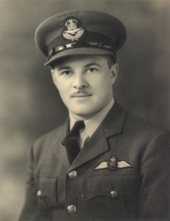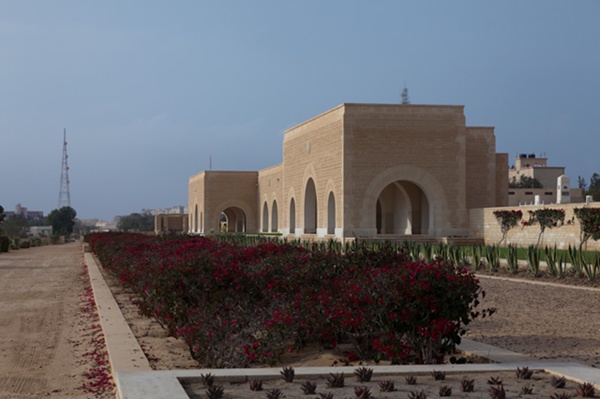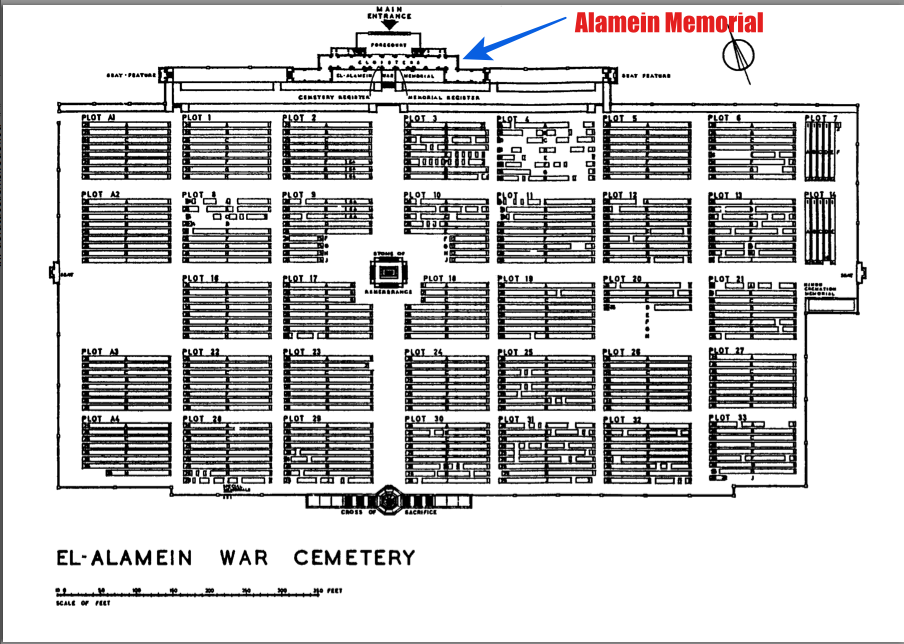ALAMEIN MEMORIAL
Alamein
Egypt
Location Information
Alamein is a village, bypassed by the main coast road, approximately 130 kilometres west of Alexandria on the road to Mersa Matruh. The first Commission road direction sign is located just beyond the Alamein police checkpoint and all cemetery visitors should turn off from the main road onto the parallel old coast road.
The cemetery lies off the road beyond the ridge, and road direction signs are in place approximately 25 metres before the low metal gates and stone wing walls which are situated centrally at the road edge at the head of the access path into the cemetery. The Cross of Sacrifice feature may be seen from the road.
Visiting Information
The Alamein Memorial forms the entrance to the El Alamein War Cemetery. The cemetery is open every day from 07:00 - 17:00.
Wheelchair access to this site is signposted.
Historical Information
The campaign in the Western Desert was fought between the Commonwealth forces (with, later, the addition of two brigades of Free French and one each of Polish and Greek troops) all based in Egypt, and the Axis forces (German and Italian) based in Libya. The battlefield, across which the fighting surged back and forth between 1940 and 1942, was the 1,000 kilometres of desert between Alexandria in Egypt and Benghazi in Libya. It was a campaign of manoeuvre and movement, the objectives being the control of the Mediterranean, the link with the east through the Suez Canal, the Middle East oil supplies and the supply route to Russia through Persia.
The ALAMEIN MEMORIAL forms the entrance to El Alamein War Cemetery. The Land Forces panels commemorate more than 8,500 soldiers of the Commonwealth who died in the campaigns in Egypt and Libya, and in the operations of the Eighth Army in Tunisia up to 19 February 1943, who have no known grave. It also commemorates those who served and died in Syria, Lebanon, Iraq and Persia.
The Air Forces panels commemorate more than 3,000 airmen of the Commonwealth who died in the campaigns in Egypt, Libya, Syria, Lebanon, Iraq, Greece, Crete and the Aegean, Ethiopia, Eritrea and the Somalilands, the Sudan, East Africa, Aden and Madagascar, who have no known grave. Those who served with the Rhodesian and South African Air Training Scheme and have no known grave are also commemorated here.
The Memorial was designed by Sir Hubert Worthington and unveiled by Field Marshal The Rt. Hon. Viscout Montgomery of Alamein on 24 October 1954.
EL ALAMEIN WAR CEMETERY contains the graves of men who died at all stages of the Western Desert campaigns, brought in from a wide area, but especially those who died in the Battle of El Alamein at the end of October 1942 and in the period immediately before that.
The cemetery now contains 7,239 Commonwealth burials of the Second World War, of which 814 are unidentified. There are also 102 war graves of other nationalities.
The ALAMEIN CREMATION MEMORIAL, which stands in the south-eastern part of El Alamein War Cemetery, commemorates more than 600 men whose remains were cremated in Egypt and Libya during the war, in accordance with their faith.
Alamein is a village, bypassed by the main coast road, approximately 130 kilometres west of Alexandria on the road to Mersa Matruh. The first Commission road direction sign is located just beyond the Alamein police checkpoint and all cemetery visitors should turn off from the main road onto the parallel old coast road.
The cemetery lies off the road beyond the ridge, and road direction signs are in place approximately 25 metres before the low metal gates and stone wing walls which are situated centrally at the road edge at the head of the access path into the cemetery. The Cross of Sacrifice feature may be seen from the road.
Visiting Information
The Alamein Memorial forms the entrance to the El Alamein War Cemetery. The cemetery is open every day from 07:00 - 17:00.
Wheelchair access to this site is signposted.
Historical Information
The campaign in the Western Desert was fought between the Commonwealth forces (with, later, the addition of two brigades of Free French and one each of Polish and Greek troops) all based in Egypt, and the Axis forces (German and Italian) based in Libya. The battlefield, across which the fighting surged back and forth between 1940 and 1942, was the 1,000 kilometres of desert between Alexandria in Egypt and Benghazi in Libya. It was a campaign of manoeuvre and movement, the objectives being the control of the Mediterranean, the link with the east through the Suez Canal, the Middle East oil supplies and the supply route to Russia through Persia.
The ALAMEIN MEMORIAL forms the entrance to El Alamein War Cemetery. The Land Forces panels commemorate more than 8,500 soldiers of the Commonwealth who died in the campaigns in Egypt and Libya, and in the operations of the Eighth Army in Tunisia up to 19 February 1943, who have no known grave. It also commemorates those who served and died in Syria, Lebanon, Iraq and Persia.
The Air Forces panels commemorate more than 3,000 airmen of the Commonwealth who died in the campaigns in Egypt, Libya, Syria, Lebanon, Iraq, Greece, Crete and the Aegean, Ethiopia, Eritrea and the Somalilands, the Sudan, East Africa, Aden and Madagascar, who have no known grave. Those who served with the Rhodesian and South African Air Training Scheme and have no known grave are also commemorated here.
The Memorial was designed by Sir Hubert Worthington and unveiled by Field Marshal The Rt. Hon. Viscout Montgomery of Alamein on 24 October 1954.
EL ALAMEIN WAR CEMETERY contains the graves of men who died at all stages of the Western Desert campaigns, brought in from a wide area, but especially those who died in the Battle of El Alamein at the end of October 1942 and in the period immediately before that.
The cemetery now contains 7,239 Commonwealth burials of the Second World War, of which 814 are unidentified. There are also 102 war graves of other nationalities.
The ALAMEIN CREMATION MEMORIAL, which stands in the south-eastern part of El Alamein War Cemetery, commemorates more than 600 men whose remains were cremated in Egypt and Libya during the war, in accordance with their faith.

J/6402 Flying Officer
Haraldur Johannes Davidson
47 Squadron, Royal Canadian Air Force
26th October 1942, aged 29.
Column 263.
Son of Mr. and Mrs. H. F. Davidson; husband of Bertha L. Davidson, of Winnipeg, Manitoba, Canada.
Born in Winnipeg, Manitoba on August 1,1912 to parents of Icelandic descent, Ragnheidur and Haraldur F. Davidson.
He was employed by the T. Eaton Company from 1929 until 1940 when he enlisted in the RCAF.
Haraldur took his training in Eastern Canada, Prince Edward Island, and Saskatoon, Saskatchewan where he graduated as a pilot.
He embarked for overseas duty in October 1941 and was sent to Egypt early in 1942. He was the pilot of a Beaufort aircraft with 47 Squadron and was reported missing and presumed to have lost his life on October 26, 1942 as a result of air operations. It was his first operation. He is commemorated on Air Force panel at the El Alamein Memorial and has no known grave.
He was survived by Bertha, his wife and a daughter Diane.
He was awarded the 39-45 Star, the Africa Star, the Defence Medal, the General Service Medal and the Canadian Volunteers Service Medal.
In 1996 the government of Manitoba named a point of land on Lake Shannon in Northern Manitoba “Davidson Point” in his honour.
Picture and information courtesy of Haraldur's daughter Diane (Davidson) Thornquist
Haraldur Johannes Davidson
47 Squadron, Royal Canadian Air Force
26th October 1942, aged 29.
Column 263.
Son of Mr. and Mrs. H. F. Davidson; husband of Bertha L. Davidson, of Winnipeg, Manitoba, Canada.
Born in Winnipeg, Manitoba on August 1,1912 to parents of Icelandic descent, Ragnheidur and Haraldur F. Davidson.
He was employed by the T. Eaton Company from 1929 until 1940 when he enlisted in the RCAF.
Haraldur took his training in Eastern Canada, Prince Edward Island, and Saskatoon, Saskatchewan where he graduated as a pilot.
He embarked for overseas duty in October 1941 and was sent to Egypt early in 1942. He was the pilot of a Beaufort aircraft with 47 Squadron and was reported missing and presumed to have lost his life on October 26, 1942 as a result of air operations. It was his first operation. He is commemorated on Air Force panel at the El Alamein Memorial and has no known grave.
He was survived by Bertha, his wife and a daughter Diane.
He was awarded the 39-45 Star, the Africa Star, the Defence Medal, the General Service Medal and the Canadian Volunteers Service Medal.
In 1996 the government of Manitoba named a point of land on Lake Shannon in Northern Manitoba “Davidson Point” in his honour.
Picture and information courtesy of Haraldur's daughter Diane (Davidson) Thornquist

920788 Sergeant
George Henry Hellyer
38 Squadron, Royal Air Force Volunteer Reserve
20th November 1941, aged 23.
Column 243.
Son of George Henry and Ellen Hellyer, of Plymouth.
George Henry Hellyer
38 Squadron, Royal Air Force Volunteer Reserve
20th November 1941, aged 23.
Column 243.
Son of George Henry and Ellen Hellyer, of Plymouth.






